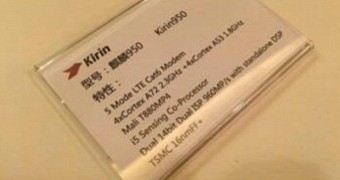Chinese handset maker Huawei is expected to launch another flagship smartphone on November 26, Mate 8. The phablet was teased earlier this week and is said to pack one of the most powerful mobile chipsets soon to be available on the market, Kirin 950.
Today, Huawei officially unveiled the latest version of its mobile chipset and provided us with information on what's inside, as well as what makes it so powerful over others, AndroidCentral reports.
Those who have been following previous news about Huawei's Kirin 950 already know that the chipset overtakes Samsung's Exynos 7420 SoC (system-on-chip), which is why it's seen as one of the most powerful on the market after all.
It uses 16nm manufacturing process and supports VoLTE
Huawei Kirin 950 has been manufactured using the 16nm FinFET process by TSMC. The chipset has been confirmed to use big.LITTLE architecture and packs four A-72 cores clocked at 2.53GHz for the most demanding tasks.
In addition, the chipset features another four A-53 cores clocked at 1.8GHz, which should provide the necessary speed for all those apps and services that are usually light on CPU.
On top of that, Kirin 950 features a very small i5 co-processor, which Huawei says that it's “always sensing,” whatever that means.
Furthermore, Huawei Kirin 950 comes with full support for LTE Cat.6 connectivity, as well as VoLTE (voice over LTE) for those smartphones and carriers that support the technology.
When it comes to graphics, Kirin 950 doesn't disappoint. The chipset packs a powerful Mali-T880MP4 graphics processing unit, which should provide a smooth gameplay experience in any given scenario.
If you already own a Huawei smartphone powered by a previous generation of Kirin chipsets, then you should know the Kirin 950 offers a 100% performance improvement over the Kirin 925, which is the current generation.
In order to prove that, let's just wait for the launch of Huawei Mate 8 for more synthetic benchmarks of the new Kirin 950 chipset.

 14 DAY TRIAL //
14 DAY TRIAL //